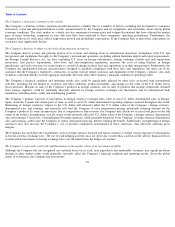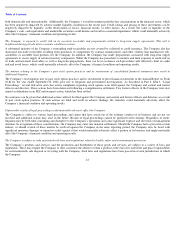Apple 2009 Annual Report Download - page 24
Download and view the complete annual report
Please find page 24 of the 2009 Apple annual report below. You can navigate through the pages in the report by either clicking on the pages listed below, or by using the keyword search tool below to find specific information within the annual report.
Table of Contents
Political events, war, terrorism, public health issues, natural disasters and other circumstances could materially adversely affect the Company.
War, terrorism, geopolitical uncertainties, public health issues, and other business interruptions have caused and could cause damage or
disruption to international commerce and the global economy, and thus could have a strong negative effect on the Company, its suppliers,
logistics providers, manufacturing vendors and customers, including channel partners. The Company’
s business operations are subject to
interruption by natural disasters, fire, power shortages, terrorist attacks, and other hostile acts, labor disputes, public health issues, and other
events beyond its control. Such events could decrease demand for the Company’
s products, make it difficult or impossible for the Company to
make and deliver products to its customers, including channel partners, or to receive components from its suppliers, and create delays and
inefficiencies in the Company’
s supply chain. Should major public health issues, including pandemics, arise, the Company could be negatively
affected by more stringent employee travel restrictions, additional limitations in freight services, governmental actions limiting the movement of
products between regions, delays in production ramps of new products, and disruptions in the operations of the Company’
s manufacturing
vendors and component suppliers. The majority of the Company’
s research and development activities, its corporate headquarters, information
technology systems, and other critical business operations, including certain component suppliers and manufacturing vendors, are located near
major seismic faults. Because the Company does not carry earthquake insurance for direct quake-
related losses and significant recovery time
could be required to resume operations, the Company’
s financial condition and operating results could be materially adversely affected in the
event of a major earthquake.
The Company may be subject to information technology system failures, network disruptions and breaches in data security.
Information technology system failures, network disruptions and breaches of data security caused by such factors including without limitation
earthquakes, fire, theft, or other causes could disrupt the Company’
s operations by causing delays or cancellation of customer, including channel
partner, orders, negatively affecting the Company’
s online, iTunes, MobileMe and retail offerings and services, impeding the manufacture or
shipment of products, processing transactions and reporting financial results, resulting in the unintentional disclosure of customer or Company
information, or damage to the Company’
s reputation. While management has taken steps to address these concerns by implementing
sophisticated network security and internal control measures, there can be no assurance that a system failure or loss or data security breach will
not materially adversely affect the Company’s financial condition and operating results.
The Company expects its quarterly revenue and operating results to fluctuate for a variety of reasons.
The Company’s profit margins vary among its products and its distribution channels. The Company’
s software, accessories, and service and
support contracts generally have higher gross margins than certain of the Company’s other products. Gross margins on the Company’
s hardware
products vary across product lines and can change over time as a result of product transitions, pricing and configuration changes, and
component, warranty, and other cost fluctuations. The Company’
s direct sales generally have higher associated gross margins than its indirect
sales through its channel partners. In addition, the Company’
s gross margin and operating margin percentages, as well as overall profitability,
may be materially adversely impacted as a result of a shift in product, geographic or channel mix, new products, component cost increases,
strengthening U.S. dollar, or price competition. The Company has typically experienced greater net sales in the first and fourth fiscal quarters
compared to the second and third fiscal quarters due to seasonal demand related to the holiday season and the beginning of the school year,
respectively. Furthermore, the Company sells more products from time-to-
time during the third month of a quarter than it does during either of
the first two months. Developments late in a quarter, such as lower-than-anticipated demand for the Company’
s products, an internal systems
failure, or failure of one of the Company’
s key logistics, components supply, or manufacturing partners, could have a material adverse impact on
the Company’s financial condition and operating results.
21
























